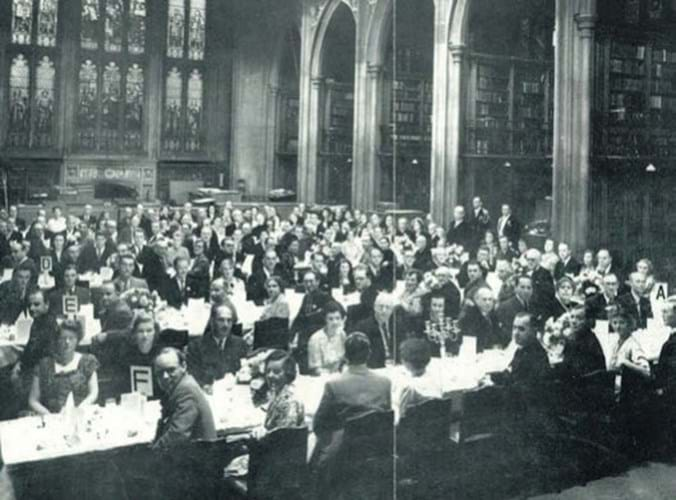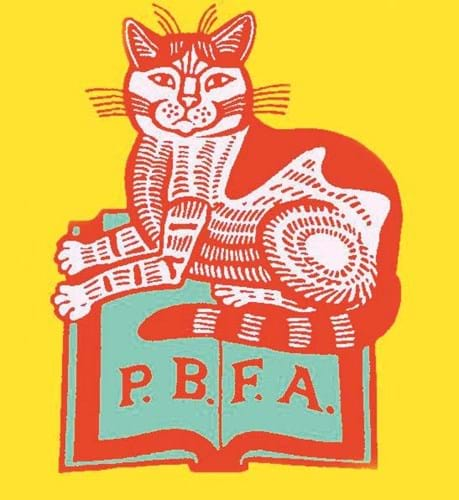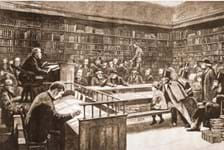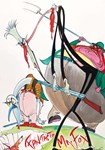
1906
Following a general meeting of booksellers held at the Criterion Restaurant in Piccadilly Circus on December 11, The Secondhand Booksellers’ Association is created. The 112 founder members pay a subscription of five shillings.
1908
As informal links are established with overseas dealers, the association rebrands as the International Association of Antiquarian Booksellers (IABA).
1912
An exhibition is organised by the IABA at the Stationers’ Hall in the City of London. A fully-indexed catalogue of 1200 items from members’ stock includes 15 Caxtons.
1914
The Syndicat National de la Librairie Ancienne et Moderne, an association for French booksellers, is created in Paris.
1920
A Danish book dealers’ association is established. Other Scandinavian countries follow suit in the following decades: Sweden (1936), Finland (1941) and Norway (1942).
1928
Having survived an earlier vote to change its name to the Antiquarian Bookman’s Association, the ABA adopts in current name: Antiquarian Booksellers’ Association (International).
1937
The ABA adopts its current logo. Efforts to get Eric Gill to contribute are unsuccessful.
1938
The Sunday Times Book Fair is launched with some success but abandoned for the following year as war breaks out.
1939
The ABA rules of membership are changed to ensure members are ‘persons of integrity not only in methods of payment but also in the authenticity and reliability of the goods they offer’.
1945
As the war draws to an end the first ABA newsletter, titled What your Committee is Doing, is published.
1947
Dealers from across Europe attend a conference of Dutch booksellers in Amsterdam where the seeds of the International League of Antiquarian Booksellers are planted.
1948
At a second conference in Copenhagen the ILAB is formally incorporated with associations from 10 countries.
1948
The Northern Branch of the ABA, the first of a series of regional outposts, is created. The first series of ABA lectures is held in the winter.
1949
The Antiquarian Booksellers’ Association of America is created to promote standards and professionalism in the US. Antiquarian booksellers in Brazil (1945), Belgium (1946), Italy (1947), Germany and Austria (1949) also form associations in this period.
1958
The London Book Fair brings together 28 ABA members for a 10-day show at the National Book League in Albemarle Street. It is considered the first of the profusion of UK antiquarian and second-hand book fairs.
1960s
A campaign across the trade seeks to keep books free from VAT. Printed books remain zero-rated but unbound autographs no longer escape.

The ABA fair at the National Book League in 1969.
1972
Eight regional book dealers – none of them ABA members – club together to hold a monthly fair at the Hotel Eden in London’s South Kensington. The fair moves to the National Book League and then to the Kenilworth Hotel.
1973
Following the birth of a Scottish ABA branch the previous year, the Edinburgh Book Fair is launched. An Eastern branch hosts the Cambridge Book Fair the following year.
1974
Now holding fairs in London, Liverpool, Loughborough, Bath and York, The Provincial Booksellers’ Fairs Association is founded. It plans to be an inclusive organisation open to both full and part-time booksellers.
1975
The buyer’s premium is introduced by London’s two largest auction houses. ABA president Charles Swann leads a walk-out of members from Sotheby’s and Christie’s sales in October.
1980
The PBFA host its 100th London fair. The association arranges a ‘Computer Conference’ in Oxford to study the potential uses of new technology in antiquarian bookselling.
1983
The PBFA logo, now displayed by over 600 members, is redesigned by Edward Bawden to include his cat Emma Nelson reclining on an open book.
1986
The PBFA’s series of light-hearted exhibitions, that had begun in 1982 with All Time Dud Books at the York fair, reaches a peak with Hideous Bindings at the Russell Hotel, London.
1990
Now holding almost 200 events a year, the PBFA launches its own credit union. Having outgrown its offices in Cambridge the association purchases premises in Royston.
2006
The ABA, the oldest organisation of its kind in the world, marks its centenary.
2014
The PBFA marks its 40th anniversary. While numbers have shrunk, the association currently holds over 60 fairs a year including seven premier events (see Calendar of Events, page 40-46).
2016
The ABA and the British Antique Dealers’ Association sign a memorandum of understanding, agreeing to work together more closely.
Rare Books London is launched bringing together a number of fairs and sales under the same umbrella.














